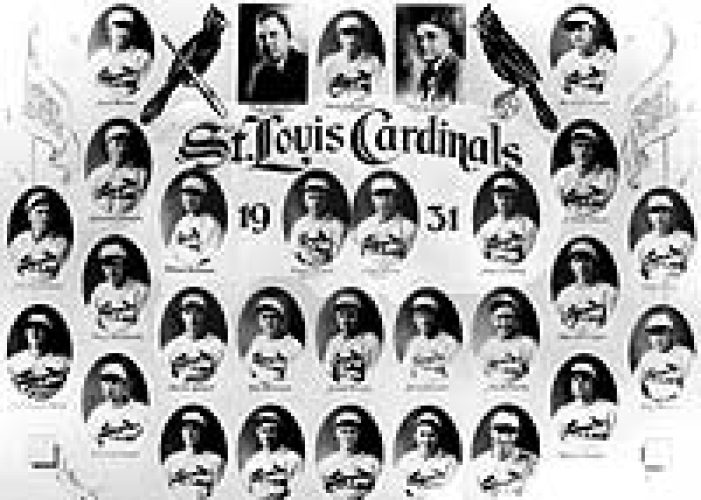Those Philadelphia Athletics were at it again in 1931. They captured their third straight American League pennant — winning 107 games — and pushed their three-year victory total to 313.
Al Simmons and Lefty Grove symbolized the cut-above nature of the Athletics. Simmons won his second consecutive AL batting title with a .390 average, nine points higher than his ’30 average, and added 22 home runs and 128 runs batted in. Grove won 16 consecutive decisions beginning in early June and finished 31-4. In Philadelphia’s pennant run from 1929 through ’31, the lefthander was 79-15.
Simmons and Grove did business as usual in Game 1 of the 1931 World Series, which again matched Connie Mack’s Athletics against Gabby Street’s St. Louis Cardinals. Grove permitted two first-inning runs, then shut out the Cards the rest of the way. Simmons rocketed a two-run home run in the seventh, and Philadelphia was off and running with a 6-2 triumph in its quest to become the first club to win three straight Series titles. Grove wasn’t his usual stingy self, to be sure. He allowed 12 hits, including three by Cardinals center fielder Pepper Martin.
Among everyday players, Martin was the lone change from Cardinals’ cast of 1930. Martin, a “gamer” in every sense of word, had exhibited his all-out style of play in seven minor-league seasons and two brief stints with the Cards before cracking the St. Louis lineup in ’31. A full-time major leaguer for the first time at 27, Martin responded by batting .300.
In Game 2 of the Series, Martin and Wild Bill Hallahan thwarted the Athletics. Martin doubled in the second inning, stole third and scored on a fly ball. Then, in the seventh, he singled, stole second, advanced to third on a groundout and scored on a squeeze bunt. That was the extent of the Cardinals’ offense, but it was enough. Despite living up to his nickname and issuing seven walks, Hallahan was miserly in the hit department. In fact, the Athletics were hitless until the fifth inning and wound up with only three hits overall. The Cards won, 2-0.
Burleigh Grimes, a 17-game winner for St. Louis at 38, pitched brilliantly in the next contest. While Grimes’ specialty, the spitball, had been outlawed in 1920, those using the wet pitch on the major-league level at the time of the rules change were given permission to throw it for the rest of their careers. Eleven years later, Grimes still was pitching. And he still was “loading up.” And he still was winning, as the A’s discovered in Game 3 of the 1931 Series. Grimes threw no-hit ball through seven innings, finished with a two-hitter and even came through with a two-run single in a 5-2 victory. Batterymate Jimmie Wilson had three hits, and Martin two.
The excellent pitching in this Series continued when Philadelphia’s George Earnshaw, a 20-game winner for the third consecutive season, spun a two-hitter in the fourth game. The Cardinals’ hits were a fifth-inning single and an eighth-inning double — both Martin. Jimmie Foxx hit a bases-empty homer for the A’s, who were 3-0 winners.
For Game 5, Mack turned to a 32-year-old righthander with vast experience, Waite Hoyt, who had been obtained on waivers from the Detroit Tigers in June. Hoyt had pitched in six Series for the New York Yankees and compiled a 6-3 record for the Yanks in the fall classic. Street nominated Hallahan. The victory went to Hallahan, but once again the headlines went to Martin. Pepper hit a run-scoring fly ball in the first inning, a two-run homer in the sixth and a run-scoring single in the eighth. He also beat out a bunt for a base hit in the fourth. Martin’s four-RBI performance backed Hallahan’s solid pitching and the Cardinals prevailed, 5-1.
After five games, St. Louis had three victories. And Martin had a .667 batting average (12 hits in 18 at-bats, five runs scored, four doubles, one home run, five RBls and four stolen bases. The Wild Horse of the Osage was feeling his oats.
That Martin could continue — or even approximate — his pace was, of course, doubtful. And he did not. No matter. The Cardinals survived, even after St. Louis rookie pitcher Paul Derringer absorbed his second Series defeat in Game 6, a contest in which the A’s broke loose for two four-run innings and rolled to an 8-1 victory. Grove tossed a five-hitter in the Series-squaring game.
In the decisive seventh game, St. Louis’ Andy High and George Watkins –terribly unproductive in the Series to that point (3-for-22) — came alive. They scored all four of the Cardinals’ runs and collected all five of their hits. After a wild pitch and an error helped St. Louis to two first-inning runs, third baseman High singled in the third and right fielder Watkins followed with a home run that staked Grimes to a 4-0 lead. Grimes pitched shutout ball through the eighth inning, but he faltered in the ninth and needed last-out relief help from Hallahan. That final out in the Cardinals’ 4-2 triumph came on a fly ball to Martin, who earlier had made things happen for the Cards and now, fittingly, put an end to the proceedings. St. Louis was the World Series titleist for the second time.
Martin, hitless in Games 6 and 7, nevertheless wound up with a .500 average. And he stole his fifth base of the Series in the first inning of the finale.
Come to think of it, Pepper Martin stole the show in the 1931 World Series. Period.




